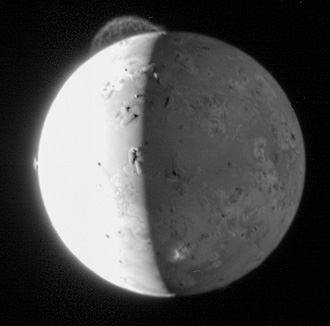The big plume, in the 11 o'clock area in the photo, is no less than 290 kilometers high. The spacecraft has left Jupiter and will continue towards Pluto but will continue to transmit hundreds more images it took

The impressive image of Io was captured by the Long Range Reconnaissance Imager (LORRI) camera on board the New Horizons spacecraft on February 28, 2007, about five hours after its closest approach to Jupiter. The distance from it to the moon Io was about 2.5 million km. In the center of the picture is longitude 85 west. From this distance, each Lori pixel means 12 km on an island.
The processed image provides the best view of a 290-kilometer-high plume from Tabashtar Volcano at 11 o'clock, near Io's north pole. The plume was first seen by the Hubble Space Telescope about weeks ago and again when New Horizons arrived in the area on February 26. This image is clearer than the one on February 26 because Io was closer to the spacecraft, and the plume is also brighter by the sun. Also, the exposure time is longer - 75 milliseconds compared to 20 milliseconds in the previous photo.
Io's day side is overexposed in this image so that the pale plumes can be captured, and the long exposure also provided a nice view of Io's night side illuminated by Jupiter. The configuration of the long thread in the plume coming out of the Tabashtar mountain is similar in detail to the pale plume photographed by the Voyager spacecraft in 1979 coming out of the Pella Bayou volcano. However, no previous images taken by any spacecraft have shown the mysterious structure so clearly.
The image also reveals a much smaller, symmetrical plume fountain about 60 kilometers above Prometheus Volcano, at 9 o'clock. The culmination of a third volcanic eruption, from Masubi Volcano, rose high enough to catch the setting sun on the night side near the bottom of the image as a smudge. Bright against the Jupiter-lit surface of Io. Several Everest-sized mountains are highlighted by the setting sun along the line of light that separates day from night.
This is the latest image in a batch of images sent back by the New Horizons spacecraft from the Lowry camera during its busy encounter with Jupiter. Hundreds of images from other spacecraft cameras were taken and stored in the spacecraft's computer memory. The rest of the images will be transmitted to Earth during the following weeks and months, during which the spacecraft will accelerate its speed on its way to Pluto.

7 תגובות
Rarkakrakrakrakraraggerkaraaraaaaaaaeeidaine
Hello Tamiouahtashchiliniekachtoihaniniehiitzinzel Manhai
He will make a name for himself
Hello to you, hello to you, hello to you
290 kilometers of magma? to height It's really appropriate to call it "flume".
Look for the answer in the previous article, and in general - that's why there is the line "from the experts" so that you can easily reach previous articles and find the answers, I'm not answering you anymore, and if you overcome your block again I'll simply delete the comments even after they're on the site.
https://www.hayadan.org.il/new-horisons-on-the-way-to-jupiter-2101074/
She asked Avi Bilovski how long the trip to Pluto would take
Really stunning photo.